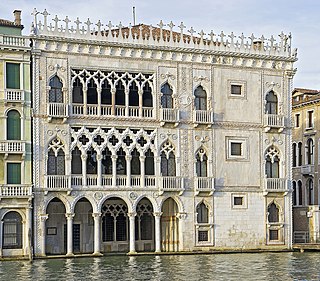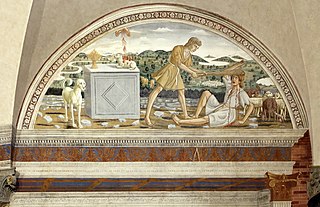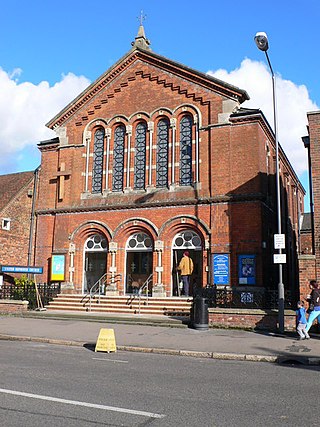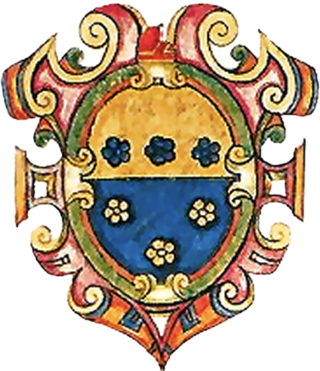
The Grand Canal is a channel in Venice, Italy. It forms one of the major water-traffic corridors in the city.

The Ca' d'Oro or Palazzo Santa Sofia is a palace on the Grand Canal in Venice, northern Italy. One of the older palaces in the city, its name means "golden house" due to the gilt and polychrome external decorations which once adorned its walls. Since 1927, it has been used as a museum, as the Galleria Giorgio Franchetti.

Leonardo Loredan was a Venetian nobleman and statesman who reigned as the 75th Doge of Venice from 1501 until his death in 1521. As a wartime ruler, he was one of the most important doges in the history of Venice. In the dramatic events of the early 16th century, Loredan's Machiavellian plots and cunning political manoeuvres against the League of Cambrai, the Ottomans, the Mamluks, the Pope, the Republic of Genoa, the Holy Roman Empire, the French, the Egyptians and the Portuguese saved Venice from downfall.

Palazzo Grassi is a building in the Venetian Classical style located on the Grand Canal of Venice (Italy), between the Palazzo Moro Lin and the campo San Samuele.

Santa Maria Formosa, formally The Church of the Purification of Mary, is a church in Venice, northern Italy. It was erected in 1492 under the design by Renaissance architect Mauro Codussi. It lies on the site of a previous church dating from the 7th century, which, according to tradition, was one of the eight founded by San Magno, bishop of Oderzo. The name "formosa" relates to an alleged appearance of the Holy Virgin disguised as a voluptuous woman1.
The decade of the 1460s in art involved some significant events.

San Francesco della Vigna is a Roman Catholic church in the Sestiere of Castello in Venice, northern Italy.

The House of Loredan is a Venetian noble family of supposed ancient Roman origin, which has played a significant role in shaping the history of the entire Mediterranean. A political dynasty, the family has throughout the centuries produced a number of famous personalities: doges, statesmen, magnates, financiers, diplomats, procurators, military commanders, naval captains, church dignitaries, writers, and lawyers.

The Palazzo Grimani of Santa Maria Formosa is a State museum, located in Venice in the Castello district, near Campo Santa Maria Formosa.

The Palazzo or Ca' Cappello Layard is a palace situated in the sestiere of San Polo of Venice, Italy, overlooking the Grand Canal at the confluence between this and the smaller Rio di San Polo and Rio delle Erbe. On the Grand canal, it is located between Palazzo Barbarigo della Terrazza and Palazzo Grimani Marcello. It is particularly noteworthy for having been the residence of Austen Henry Layard, discoverer of Nineveh.

The Pinacoteca Comunale ofCittà di Castello is the main museum of paintings and arts of Umbria Italian Region, alongside the Perugia's National gallery, and it's housed in a renaissance palace, generally preserved in its original form.

The Galleria Giorgio Franchetti alla Ca' d'Oro is an art museum located in the Ca' d'Oro on the Grand Canal in Venice, Italy.

Bernardo di Stefano Rosselli was an Italian painter active in his native Florence and the surrounding countryside.

Polifora is a type of the multi-light window. It appears in towers and belfries on top floors, where it is necessary to lighten the structure with wider openings. The term polifora usually refers to the window with at least five parts.

Palazzo Civran Grimani is a Neoclassical palace in Venice, Italy. The palazzo is located in the San Polo district, overlooking the Grand Canal at the confluence with Rio della Frescada, between Palazzo Dandolo Paolucci and Palazzo Caotorta-Angaran.
This is an alphabetical index of people, places, things, and concepts related to or originating from the Republic of Venice. Feel free to add more, and create missing pages.

The House of Loredan-Santo Stefano was a cadet branch of the House of Loredan that existed from the 14th century until 1767. The branch was mainly settled in the Palazzo Loredan in Campo Santo Stefano, which they acquired in 1536 from the Mocenigo family. The progenitor of the branch is considered to be Gerolamo Loredan "dal Barbaro" di S. Vitale (d.~1474), father of Doge Leonardo Loredan and Dogaressa Caterina Loredan. Besides Leonardo, the branch also gave Doge Francesco Loredan.
















